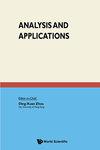用Green核方法再现Sobolev–Slobodeckij̆空间的核:理论与应用
IF 2
2区 数学
Q1 MATHEMATICS
引用次数: 0
摘要
本文以两种不同的方式扩展了Fasshauer和Ye的工作[通过带有微分算子和边界算子的Green核方法再现Sobolev空间的核,Adv.Comput.Math.38(4)(2011)891921],即新核和相关的原生空间被确定为应用数学中的关键Hilbert空间。这些空间包括以下定义在具有光滑边界的有界域[公式:见文本]中的空间:齐次Sobolev–Slobodeckij̆空间,由[公式:见图文本]表示,以及Sobolev-Slobodeckikĭ;空间(由[公式:见文本]表示),其中[公式:参见文本]。我们的目标是通过获得通过插值理论定义的包含分数拉普拉斯算子和分数微分算子的方程的格林解来实现的。我们提供了一个证明,满足这些问题的格林核分别是[公式:见正文]和[公式:看正文]的对称和正定再生核。以这两种方式构造核使得能够基于函数的正则性来表征原生空间中的函数。基于这些核的Galerkin/配置方法被用于求解各种分数问题,提供了显式或简化的计算和有效的解。这种方法在降低计算成本的情况下产生了改进的结果,使其适用于复杂领域。本文章由计算机程序翻译,如有差异,请以英文原文为准。
Reproducing kernels of Sobolev–Slobodeckij̆ spaces via Green’s kernel approach: Theory and applications
This paper extends the work of Fasshauer and Ye [Reproducing kernels of Sobolev spaces via a Green kernel approach with differential operators and boundary operators, Adv. Comput. Math. 38(4) (2011) 891921] in two different ways, namely, new kernels and associated native spaces are identified as crucial Hilbert spaces in applied mathematics. These spaces include the following spaces defined in bounded domains [Formula: see text] with smooth boundary: homogeneous Sobolev–Slobodeckij̆ spaces, denoted by [Formula: see text], and Sobolev–Slobodeckij̆ spaces, denoted by [Formula: see text], where [Formula: see text]. Our goal is accomplished by obtaining the Green’s solutions of equations involving the fractional Laplacian and fractional differential operators defined through interpolation theory. We provide a proof that the Green’s kernels satisfying these problems are symmetric and positive definite reproducing kernels of [Formula: see text] and [Formula: see text], respectively. Constructing kernels in these two ways enables the characterization of functions in native spaces based on their regularity. The Galerkin/collocation method, based on these kernels, is employed to solve various fractional problems, offering explicit or simplified calculations and efficient solutions. This method yields improved results with reduced computational costs, making it suitable for complex domains.
求助全文
通过发布文献求助,成功后即可免费获取论文全文。
去求助
来源期刊
CiteScore
3.90
自引率
4.50%
发文量
29
审稿时长
>12 weeks
期刊介绍:
Analysis and Applications publishes high quality mathematical papers that treat those parts of analysis which have direct or potential applications to the physical and biological sciences and engineering. Some of the topics from analysis include approximation theory, asymptotic analysis, calculus of variations, integral equations, integral transforms, ordinary and partial differential equations, delay differential equations, and perturbation methods. The primary aim of the journal is to encourage the development of new techniques and results in applied analysis.

 求助内容:
求助内容: 应助结果提醒方式:
应助结果提醒方式:


